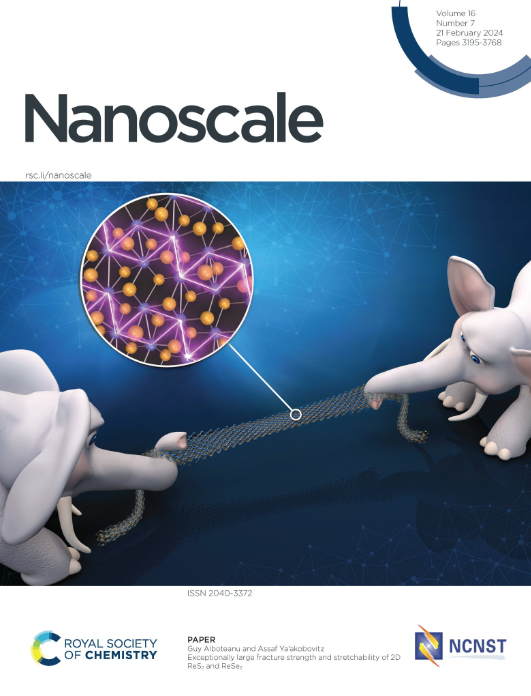基于无残基支撑层蚀刻和角应变抑制的单层MoS 2晶圆级集成
IF 5.1
3区 材料科学
Q1 CHEMISTRY, MULTIDISCIPLINARY
引用次数: 0
摘要
对于大面积、原子级薄的二维过渡金属二硫族化合物(如MoS2和WS2),无裂纹和无残留物转移技术对于将其集成到下一代电子器件中至关重要,无论是作为替代硅的通道材料,还是作为CMOS平台上3d集成纳米系统中的后端(BEOL)组件。然而,在TMDCs从其生长基质剥离过程中,经常观察到裂纹,并且在通过湿蚀刻去除粘合支撑层后,通常会留下聚合物或金属残留物。这些问题源于脱粘过程中积累的过大角应变和由于其溶解度低而导致的支撑层不完全去除。在这项研究中,我们开发了一种新的脱粘策略以及优化的蚀刻方案来解决这些挑战。利用拉曼光谱(Raman spectroscopy)、光致发光(PL)、x射线光电子能谱(XPS)、原子力显微镜(AFM)和光学显微镜(OM)对MoS 2薄膜进行了表征,证实了优化后的工艺可以实现清洁、无裂纹和形态完整的MoS 2薄膜。无裂纹和无残余传递的成功归因于两个关键因素:(1)在剥离过程中抑制了机械弯曲,从而消除了弯曲引起的裂纹形成;(2)精确控制蚀刻剂浓度、反应时间和蚀刻后冲洗步骤,确保在不损坏MoS2膜的情况下完全去除支撑层。利用商业上可用的fab工具,如晶圆键合机和脱粘机,我们成功地展示了2英寸单层MoS2薄膜的干净转移,转移率高达95%,突出了该工艺在可扩展器件制造中的实际适用性。本文章由计算机程序翻译,如有差异,请以英文原文为准。
Wafer-Scale Integration of Monolayer MoS₂ via Residue-Free Support Layer Etching and Angular Strain Suppression
A crack-free and residue-free transfer technique for large-area, atomically-thin 2D transition metal dichalcogenides (TMDCs) such as MoS2 and WS2 is critical for their integration into next-generation electronic devices, either as channel materials replacing silicon or as back-end-of-line (BEOL) components in 3D-integrated nano-systems on CMOS platforms. However, cracks are frequently observed during the debonding of TMDCs from their growth substrates, and polymer or metal residues are often left behind after the removal of adhesive support layers via wet etching. These issues stem from excessive angular strain accumulated during debonding and the incomplete removal of support layers due to their low solubility. In this study, we developed a novel debonding strategy along with an optimized etching protocol to address these challenges. Characterization using Raman spectroscopy, photoluminescence (PL), X-ray photoelectron spectroscopy (XPS), atomic force microscopy (AFM), and optical microscopy (OM) confirmed that the optimized process enables clean, crack-free, and morphologically intact MoS₂ films. The success of the crack-free and residual-free transfer is attributed to two key factors: (1) the suppression of mechanical bending during debonding, which eliminates bending-induced crack formation; and (2) the precise control of etchant concentration, reaction duration, and post-etch rinsing steps, which ensures the complete removal of the support layer without damaging the MoS2 film. Using commercially available fab tools such as wafer bonders and debonders, we successfully demonstrated the clean transfer of a 2-inch monolayer MoS2 film with a high transfer yield of 95 %, highlighting the practical applicability of this process for scalable device fabrication.
求助全文
通过发布文献求助,成功后即可免费获取论文全文。
去求助
来源期刊

Nanoscale
CHEMISTRY, MULTIDISCIPLINARY-NANOSCIENCE & NANOTECHNOLOGY
CiteScore
12.10
自引率
3.00%
发文量
1628
审稿时长
1.6 months
期刊介绍:
Nanoscale is a high-impact international journal, publishing high-quality research across nanoscience and nanotechnology. Nanoscale publishes a full mix of research articles on experimental and theoretical work, including reviews, communications, and full papers.Highly interdisciplinary, this journal appeals to scientists, researchers and professionals interested in nanoscience and nanotechnology, quantum materials and quantum technology, including the areas of physics, chemistry, biology, medicine, materials, energy/environment, information technology, detection science, healthcare and drug discovery, and electronics.
 求助内容:
求助内容: 应助结果提醒方式:
应助结果提醒方式:


